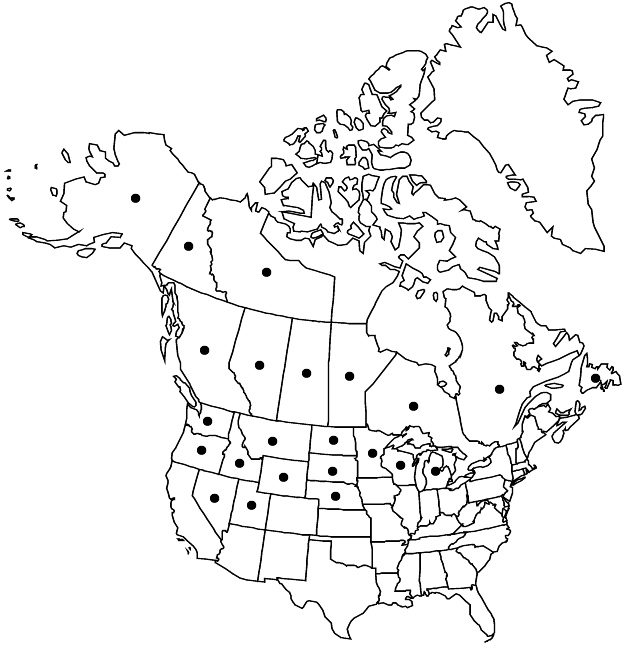Difference between revisions of "Ribes oxyacanthoides"
Sp. Pl. 1: 201. 1753 ,.
FNA>Volume Importer |
RevisionBot (talk | contribs) m (Bot: Adding category Revised Since Print) |
||
| (5 intermediate revisions by 3 users not shown) | |||
| Line 7: | Line 7: | ||
}} | }} | ||
|common_names=Canadian gooseberry | |common_names=Canadian gooseberry | ||
| + | |special_status={{Treatment/ID/Special_status | ||
| + | |code=E | ||
| + | |label=Endemic | ||
| + | }} | ||
|basionyms= | |basionyms= | ||
|synonyms= | |synonyms= | ||
| Line 19: | Line 23: | ||
-->{{Treatment/Body | -->{{Treatment/Body | ||
| − | |distribution= | + | |distribution=Alta.;B.C.;Man.;N.W.T.;Nfld. and Labr. (Nfld.);Ont.;Que.;Sask.;Yukon;Alaska;Idaho;Mich.;Minn.;Mont.;N.Dak.;Nebr.;Nev.;Oreg.;S.Dak.;Utah;Wash.;Wis.;Wyo. |
|discussion=<p>Varieties 5 (5 in the flora).</p> | |discussion=<p>Varieties 5 (5 in the flora).</p> | ||
|tables= | |tables= | ||
| Line 67: | Line 71: | ||
-->{{#Taxon: | -->{{#Taxon: | ||
name=Ribes oxyacanthoides | name=Ribes oxyacanthoides | ||
| − | |||
|authority=Linnaeus | |authority=Linnaeus | ||
|rank=species | |rank=species | ||
| Line 74: | Line 77: | ||
|basionyms= | |basionyms= | ||
|family=Grossulariaceae | |family=Grossulariaceae | ||
| − | |distribution= | + | |distribution=Alta.;B.C.;Man.;N.W.T.;Nfld. and Labr. (Nfld.);Ont.;Que.;Sask.;Yukon;Alaska;Idaho;Mich.;Minn.;Mont.;N.Dak.;Nebr.;Nev.;Oreg.;S.Dak.;Utah;Wash.;Wis.;Wyo. |
|reference=None | |reference=None | ||
|publication title=Sp. Pl. | |publication title=Sp. Pl. | ||
|publication year= | |publication year= | ||
| − | |special status= | + | |special status=Endemic |
| − | |source xml=https:// | + | |source xml=https://bitbucket.org/aafc-mbb/fna-data-curation/src/2e0870ddd59836b60bcf96646a41e87ea5a5943a/coarse_grained_fna_xml/V8/V8_75.xml |
|genus=Ribes | |genus=Ribes | ||
|species=Ribes oxyacanthoides | |species=Ribes oxyacanthoides | ||
}}<!-- | }}<!-- | ||
| − | -->[[Category:Treatment]][[Category:Ribes]] | + | --> |
| + | |||
| + | [[Category:Treatment]] | ||
| + | [[Category:Ribes]] | ||
| + | [[Category:Revised Since Print]] | ||
Latest revision as of 17:17, 6 November 2020
Plants 0.3–2 m. Stems erect or spreading, strongly puberulent, pubescence often intermixed with glandular hairs, becoming glabrate; spines at nodes 1–3 (–7), 2.2–13 mm; prickles on internodes absent or sparse to dense. Leaves: petiole (0.4–)1–4 cm, finely and softly pubescent, sparsely to densely pubescent, or pilose, and glandular-puberulent or glabrous, sometimes abaxially more glandular, or glabrous; blade roundish to reniform, 3–5(–7)-lobed, cleft 1/2 to midrib, (0.7–)1.5–4 cm, base truncate to cordate, surfaces abaxially pilose to villous, sometimes glabrate or glabrous, stipitate- and sessile-glandular, lobes oblong, oblong-cuneate, or cuneate-rounded, margins irregularly crenate-dentate into prominent, unequal teeth, apex rounded to broadly acute. Inflorescences spreading, solitary flowers or 2–3(–4)-flowered racemes, 2–3 cm, axis glabrous or stipitate-glandular and puberulent to pilose, flowers evenly spaced. Pedicels not jointed, 1–6 mm, glabrous or villous stipitate-glandular and puberulent to pilose; bracts broadly ovate-deltate, 1–2 mm (much shorter than leaves), finely glandular-ciliate. Flowers: hypanthium green or greenish white to white or pinkish, narrowly tubular or campanulate to rotate, 1.4–5.5(–6.6) mm, glabrous abaxially, villous-pubescent adaxially; sepals not overlapping, spreading to somewhat reflexed, greenish white or greenish yellow, sometimes pinkish or purplish with slightly reddish tinge, broadly to narrowly oblong-ovate or elliptic-obovate, 1–6 mm; petals connivent, becoming separated, erect, white or pinkish, oblong-oblanceolate or obovate to oblong-obovate, flabelliform-reniform, or obovate-rhombic, not conspicuously revolute or inrolled, 1–3.5 mm; nectary disc not prominent; stamens as long as or only slightly longer than petals; filaments slightly expanded at base, 0.5–3.5 mm, glabrous; anthers cream, oblong-oval, 0.6–1.3 mm, apex rounded; ovary glabrous; styles connate 1/3–3/4 their lengths, 2.5–8(–9) mm, pilose in proximal 1/2. Berries palatable, reddish, greenish purple, or deep purplish black, globose, 7–16 mm, glabrous.
Distribution

Alta., B.C., Man., N.W.T., Nfld. and Labr. (Nfld.), Ont., Que., Sask., Yukon, Alaska, Idaho, Mich., Minn., Mont., N.Dak., Nebr., Nev., Oreg., S.Dak., Utah, Wash., Wis., Wyo.
Discussion
Varieties 5 (5 in the flora).
Selected References
None.
Lower Taxa
Key
| 1 | Styles 2.5-3.3 mm; hypanthia 1.4-3 mm; sepals 1-3.3 mm. | Ribes oxyacanthoides var. hendersonii |
| 1 | Styles 5.5-9 mm; hypanthia 1.5-6.6 mm; sepals 2.5-6 mm | > 2 |
| 2 | Sepals finely pilose. | Ribes oxyacanthoides var. cognatum |
| 2 | Sepals glabrous or with scattered hairs | > 3 |
| 3 | Peduncles 6-15 mm. | Ribes oxyacanthoides var. irriguum |
| 3 | Peduncles 2-6 mm | > 4 |
| 4 | Leaf blades densely pilose abaxially, base truncate or subcordate; sepal apices rounded. | Ribes oxyacanthoides var. oxyacanthoides |
| 4 | Leaf blades finely pubescent abaxially, base deeply cordate; sepal apices truncate. | Ribes oxyacanthoides var. setosum |